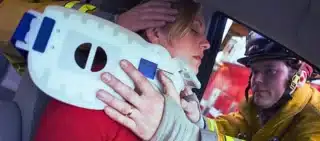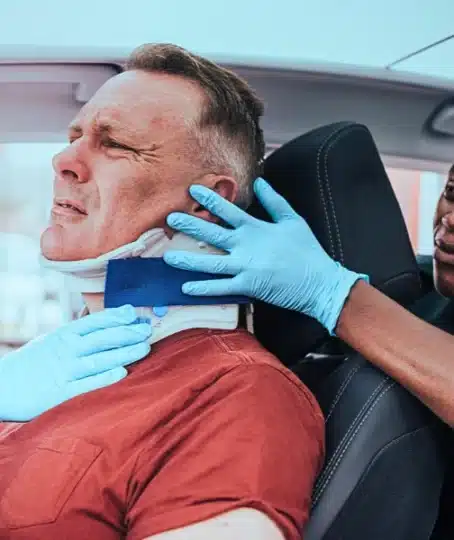
What to Do If You’re Injured in a Car Accident While Working in Illinois Work-related car accidents are common. Between...


Who pays for injuries in a car accident? In Illinois, if another party is responsible for an accident, they are accountable for all damages resulting from the incident. Conversely, if you are at fault for the accident, you will be responsible for covering damages related to your accident, as well as injuries suffered by passengers in both vehicles. If you or the other driver have insurance, it may help cover these costs; if not, the at-fault driver must pay for the damages out of pocket.

For legal representation following your accident, contact Strong Law Offices at (309) 393-2928.
If a person is responsible for an accident, they are found legally at fault for the accident and liable to compensate for your losses. In car accident claims, determining liability requires showing that the at-fault party acted negligently. Negligence happens when a driver engages in behavior that leads to injuries to others.
Negligence can include running a red light, neglecting to stop at a crosswalk or driving at excessive speeds. It can also be more subjective, such as becoming distracted while adjusting the radio or interacting with passengers.
How does Illinois determine fault in car accidents? To establish fault and liability in car accidents, it is generally necessary to demonstrate the four key elements of negligence:
The obligation of care is relevant whenever the relationship between the parties requires the defendant to act in a way to prevent harm to the plaintiff. This obligation applies on the road, as all drivers are legally mandated to demonstrate appropriate care and caution towards other drivers, passengers, motorcyclists, bicyclists, and pedestrians.
A person is deemed to have breached their duty of care if they fail to act with reasonable caution. For example, a driver might violate this duty by speeding, ignoring a stop sign, distracted while behind the wheel, or driving under the influence of alcohol.
To establish fault, it’s necessary to show that the other driver’s behavior contributed to the accident. For instance, if an oil spill on the roadway was the reason for the crash, the driver wouldn’t be held accountable. On the other hand, if the accident was due to the other driver’s reckless behavior, they would be deemed at fault. The situation and evidence related to the incident will be examined to pinpoint the factors leading to the car accident. In 2022, Illinois had 298,347 car crashes, primarily due to speeding, drunk driving, distracted driving, and aggressive driving.
To support your claim, you must show legally recognized harm from the accident, which can be car accident injuries or property damage. It's not enough to prove the other driver was negligent; you must demonstrate that their carelessness directly caused your damages. If you have no damages, your claim will fail. Damages can be economic, like medical expenses or lost income, or non-economic, such as emotional distress or physical pain.
Proving liability in a car accident relies on the quality of your evidence. Important types of evidence include police reports, medical records, witness statements and photographic or video evidence.
Fault laws for car accidents in Bloomington state that the driver found at fault, either fully or partially, can be held responsible for damages through insurance claims or personal injury lawsuits. This contrasts with “no-fault” states, where drivers seek compensation from their insurers.
In Illinois, comparative fault rules determine each party's percentage of blame based on negligence. If both drivers share responsibility for an accident, the victim's recovery is reduced by their level of fault.
For instance, if you turn left at an intersection without proper caution and another driver speeds, causing a crash, both parties share responsibility. While the speeding driver contributed, you should have been more careful before turning.
If you file a $50,000 claim but are deemed 20% at fault, you can recover $40,000, reflecting your share of responsibility.
Illinois uses a modified comparative fault system to assess the value of car accident cases. Under modified comparative fault, your compensation will be calculated based on how much fault is assigned to you. If you are found to be equally at fault or more at fault than the other person involved in the accident, you will not be able to receive any compensation. This contrasts with pure comparative fault, where you can seek compensation even if the other driver is 1% at-fault.
Typically, it's not the driver themselves who pays for car accident injuries in Illinois, but their auto insurance provider. If the insurance coverage falls short, there may be other recovery avenues, including your insurance policy, claims against third parties, and even government assistance.
Illinois's main source of compensation for car accidents is the at-fault driver's auto insurance. Drivers must have a minimum liability coverage of $25,000 per person and $50,000 per accident for bodily injury. If you file a claim against the at-fault driver, their insurance will cover damages up to those limits. For instance, if you incur $80,000 in medical expenses and lost wages, their insurance will cover that amount, provided it falls within their policy limits. If damages surpass the minimum coverage, you may need to seek additional compensation.
If the at-fault driver’s auto insurance doesn’t fully cover your damages, the next step is to pursue their assets. However, this process can be challenging or even impossible for several reasons:
As a result, while the at-fault party is legally responsible for your damages, seeking compensation against their personal assets is often not practical.
After a car accident, you may also receive compensation through your auto insurance policy if you have certain types of coverage. Key options include:
This covers repairs to your vehicle after a crash, with your insurer paying and seeking reimbursement from the at-fault driver's insurer.
This reimburses you for reasonable medical expenses after a crash, regardless of fault, providing immediate funds for bills.
This allows you to claim compensation if an uninsured or underinsured driver hits you. Your insurance can be valuable as it provides a source of recovery beyond the at-fault driver's policy. You should consider purchasing supplemental coverage if financially feasible.
In certain situations, a third party other than the driver at fault might share some responsibility for the accident.
If the accident resulted from a defect in one of the vehicles or its components (such as malfunctioning brakes or airbags that failed to deploy), you might have a product liability claim against the manufacturer. They would be accountable for compensating you for the damages caused by their defective product.
If hazardous road conditions played a role in the accident, the government body responsible for designing and maintaining that road might be liable. However, claiming against a government entity involves specific rules and deadlines.
In Illinois, dram shop laws aim to hold alcohol vendors partly responsible for over-serving that individual past the point of noticeable intoxication if they subsequently caused a drunk driving accident.
If the driver at fault was working during the accident, you could hold their employer liable. The employer’s insurance policy would then cover your damages.
These examples represent just a few third-party liabilities. Identifying all possible sources of compensation is a key reason to engage a car accident lawyer in Bloomington, IL. They can thoroughly investigate the accident to ascertain if other parties may also be at fault.
If you're in a car accident while driving for work, you can file a workers' compensation claim to cover medical expenses and a part of your lost wages. Workers' comp is a no-fault system, so you can receive benefits even if you caused the accident. If a third party is at fault, you can also pursue a personal injury claim, but your workers' comp insurer may seek reimbursement from that recovery.
After an accident, a car accident attorney can help you understand what the average settlement for a car accident is, can negotiate with insurance, gather evidence, and determine fair compensation for your injuries. For assistance with your motorcycle accident claim, contact us at Strong Law Offices.

What to Do If You’re Injured in a Car Accident While Working in Illinois Work-related car accidents are common. Between...

Why Pedestrian Accidents in Parking Lots Surge During Summer in Illinois As temperatures rise, more individuals tend to engage in...

Drowsy drivers are a serious and often overlooked danger on Illinois roads. Each year, fatigued drivers contribute to thousands of...